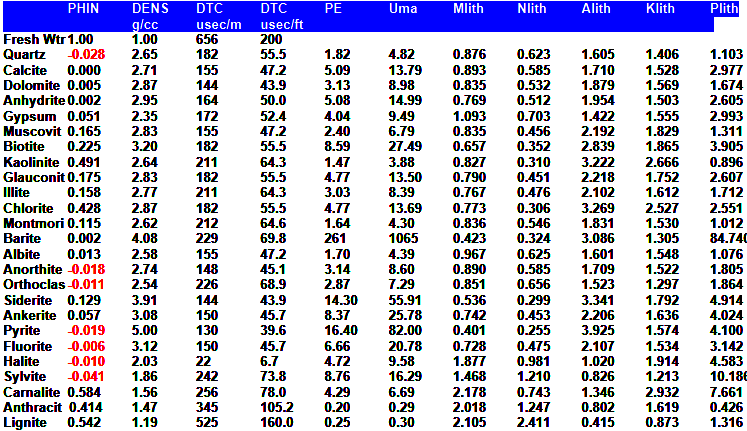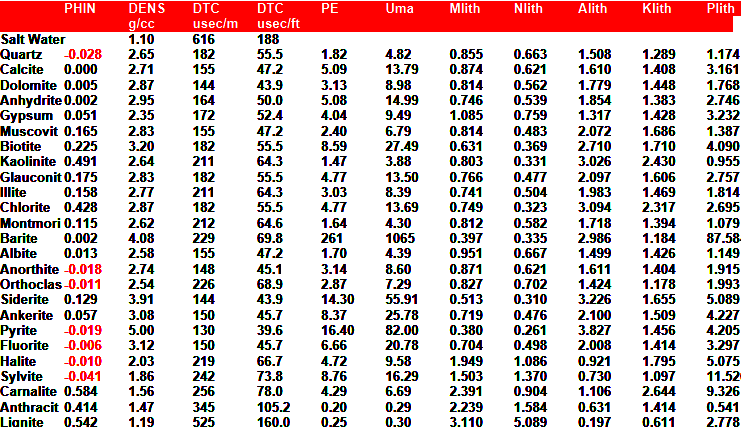|
 Porosity from Lithology
Models
Porosity from Lithology
Models
This method assumes that lithology is known from a UMA - DENSMA
3 mineral model or some other method that will determine mineral
volumes accurately. The method can also be used if Vmin1 and Vmin2
(and Vmin3 if desired) are derived from sonic density neutron
(Mlith/Nlith or DELTMA/DENSMA), core description, or sample description.
Core bulk density (or assumption) is needed for these last two.
Calculate shale density from shale porosity (a constant for each
zone):
1: DENSSH = PHIDSH * KD1 + (1 - PHIDSH) * KD2
PHIDSH and DENSSH are constants for each zone, chosen from the
density log in a nearby shale.
Translate density porosity for each layer to density units:
2: DENS = PHID * KD1 + (1 - PHID) * KD2
Where:
KD1 = 1.00 for English units
KD1 = 1000 for Metric units
KD2 = 2.65 for English units Sandstone scale log
KD2 = 2650 for Metric units Sandstone scale log
KD2 = 2.71 for English units Limestone scale log
KD2 = 2710 for Metric units Limestone scale log
KD2 = 2.87 for English units Dolomite scale log
KD2 = 2870 for Metric units Dolomite scale log
Calculate matrix density from lithology results:
3: DENSma = (Vmin1*DENS1 + Vmin2*DENS2 + Vmin3*DENS3) * (1
- Vsh)
+ Vsh * DENSSH
Calculate porosity from density response equation:
4: PHI3min = (DENS - DENSma) / (DENSW - DENSma)
Where:
DENS = density log reading in zone of interest (gm/cc or kg/m3)
DENS1 = density log reading for mineral 1 (gm/cc or kg/m3)
DENS2 = density log reading for mineral 2 (gm/cc or kg/m3)
DENS3 = density log reading for mineral 3 (gm/cc or kg/m3)
DENSma = computed density log reading in 100% matrix rock (gm/cc
or kg/m3)
DENSSH = density log reading in 100% shale (gm/cc or kg/m3)
DENSW = density log reading in 100% water (gm/cc or kg/m3)
PHID = porosity from uncorrected density log (fractional)
PHIDSH = apparent density log porosity of 100% shale (fractional)
DENS1 = density log reading for mineral 1 (gm/cc or kg/m3)
DENS2 = density log reading for mineral 2 (gm/cc or kg/m3)
DENS3 = density log reading for mineral 3 (gm/cc or kg/m3)
Vmin1 = volume of mineral 1 (fractional)\Vmin2 = volume of mineral
2 (fractional)
Vmin2 = volume of mineral 2 (fractional)
Vmin3 = volume of mineral 3 (fractional)
Vsh = shale volume (fractional)
 COMMENTS:
COMMENTS:
Use when data is available, but use care since errors in lithology
calculation or lithology assumptions are exaggerated into the porosity equation.
Do not use in bad hole conditions or in gas zones.
This method is equivalent to a 4 mineral model where one mineral
is considered to be porosity. Shale, which is calculated separately,
is a fifth mineral. The model can be rephrased as a two mineral
model by setting V3 to zero (ie Vmin1 + Vmin2 = 1.0).
To calibrate to core porosity, adjust DENS1, DENS2, DENS3, DENSSH
or Vsh to obtain a better match by trial and error. Appropriate
crossplots may assist, or regression of PHIped vs core porosity
may be used.
 LOG ANALYSIS PARAMETERS
LOG ANALYSIS PARAMETERS


|

